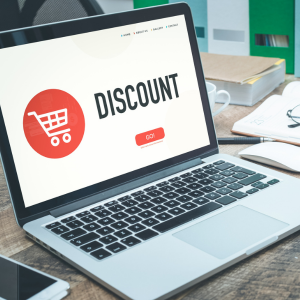First Visit Discounts Promise Nirvana and Deliver Damage

Every time a pop-up discount flashes across your website, your brand value takes a hit. While they might lift conversions momentarily, they erode trust, condition customers to wait for deals, and chip away at your margins. So, what is the alternative?
This blog explores strategic ways to boost basket completion and AOV while protecting your margins.
The Pop-Up Problem: Why Discounts Are a Race to the Bottom
We see this mistake all the time, even on leading e-commerce sites. A new customer lands on your homepage for the first time. Before they have even seen your products, a pop-up appears offering “15% off your first order.”
In that moment, you have already undercut your brand. You have told them your prices are not worth paying in full. Instead of building value, you have trained them to expect a discount.
Even worse, they close the pop-up, browse your catalogue and decide they love what they see. But now they are wondering: “Why would I pay full price when they were literally just offering me a discount?” So, they abandon their cart, expecting another offer to appear.
This scenario plays out millions of times daily across e-commerce sites, creating a cascade of problems that extend far beyond a single transaction.
Customer Conditioning: Training Shoppers to Game Your System
The most insidious effect of constant discount pop-ups is behavioural conditioning. When customers know a discount is likely coming, they adapt their shopping behaviour accordingly. They will abandon their carts, browse in incognito mode, or simply wait a few days knowing that a “special offer” will eventually appear.
This creates a perverse cycle where genuine, ready-to-buy customers are trained to become discount hunters. Your most loyal customers, those willing to pay full price, become conditioned to expect deals, fundamentally shifting their relationship with your brand from value-based to price-focused.
Reduced Brand Perception: The Luxury Trap
Constant sales and discounts signal one thing to consumers: your products are overpriced to begin with. When customers see frequent 20-30% discounts, they begin questioning the “real” value of your offerings. Why would they ever pay full price when discounts are clearly the norm?
This perception problem is particularly damaging for brands trying to position themselves as premium or luxury. Research shows that frequent discounting can reduce perceived product quality by up to 40%, making it nearly impossible to command higher prices in the long term.
Margin Erosion: The Math That Doesn’t Add Up
Let us talk numbers. If you are offering 20% discounts regularly, you need to increase your volume significantly just to maintain the same revenue. But the big issue is that you also need to factor in the increased operational costs of handling more orders, customer service, and fulfilment.
For many e-commerce businesses operating on already tight margins, this math simply does not work. A 20% discount can turn a profitable customer acquisition into a loss-making transaction, especially when you factor in the cost of paid advertising that brought them to your site in the first place.
Paid Media Waste: Throwing Good Money After Bad
Perhaps the most frustrating aspect of discount dependency is how it undermines your marketing investments. You spend £50 to acquire a customer through paid ads, only to immediately discount their purchase by 15-20%. Not only are you reducing the immediate ROI of that acquisition, but you are also training that customer to expect discounts in the future, reducing their lifetime value.
This creates a vicious cycle where you need to spend more on acquisition to compensate for lower margins, which puts even more pressure on your discount strategy.
The Sustainable Shift: Brand Partnerships That Add Value
The solution is not to abandon conversion optimisation entirely, it is to replace margin-killing discounts with value-adding strategies. This is where strategic brand partnerships, particularly gift-with-purchase (GWP) offers, become your best option.
Unlike discounts that reduce your revenue, GWP partnerships allow you to enhance the customer experience while maintaining full margins on your products. The gift comes from a partner brand, creating a win-win-win scenario: your customers get more value, your partner reaches new audiences, and you boost conversions without sacrificing profitability.
How Brand Partnerships Work
The concept is elegantly simple. Instead of offering “20% off your order,” you offer “Free wine, from a partner brand, with orders over £75” or “Complimentary mascara with every dress purchase.” The customer receives genuine added value, but your product prices remain unchanged.
These partnerships work because they:
- Tap into aligned audiences: Partner brands can introduce their products to customers who are already engaged and purchasing.
- Increase perceived basket value: Customers feel they are getting more for their money without actual price reductions.
- Enhance the unboxing experience: Thoughtful gifts create positive brand associations and encourage repeat purchases.
- Provide authentic value: Unlike arbitrary discounts, relevant gifts solve real customer needs or desires.
- Support premium positioning: By avoiding discounting and aligning with other high-quality brands, businesses retain their luxury appeal and pricing power.
Leading E-commerce brands are already benefiting from this strategy
The shift from discounts to brand partnerships is not just theoretical, leading e-commerce brands are seeing remarkable results when they make this transition.
Shark Germany: 39% Boost in Basket Completion
Shark Germany partnered with complementary home brands to offer premium cleaning accessories as gifts with purchase. Rather than discounting their vacuum cleaners, they enhanced the value proposition with relevant, useful additions. The results showed a 38.75% increase in basket completion rates, with customers feeling they were getting exceptional value rather than a “deal.”
Ninja Kitchen: Dramatic Improvements Across All Metrics
Ninja Kitchen’s partnership strategy delivered some of the most impressive results: a 58.62% lift in basket value and a 4.84% rise in average order value.
How to Make the Shift Without Wrecking UX
The transition from discount pop-ups to brand partnerships might seem daunting, but modern technology makes implementation surprisingly straightforward.
Simple Integration Options
Most partnership programmes can be integrated using existing tools like Awin MasterTag or Google Tag Manager. This means you do not need extensive development resources or major website changes. The technical barrier to entry is minimal, making it easy to test and iterate.
Built for Testing and Optimisation
Just like paid advertising campaigns, brand partnership offers can be A/B tested and optimised for performance. You can test different gift offerings, threshold amounts, messaging, and timing to find what resonates best with your specific audience.
This flexibility allows you to approach partnerships with the same data-driven mindset you would apply to any other marketing channel, ensuring you can continuously improve results over time.
Personalisation and Relevance
Advanced partnership platforms allow for sophisticated targeting and personalisation. You can offer skincare gifts to beauty customers, tech accessories to electronics buyers, or gourmet snacks to food and beverage purchasers. This level of relevance makes the offers feel curated rather than generic, significantly improving their effectiveness.
The key is ensuring that partnerships feel natural and valuable rather than forced or promotional. When done right, customers should feel excited about the gift, not suspicious about the motivation behind it.
From Reactive Discounts to Strategic Value
The fundamental difference between discount pop-ups and strategic brand partnerships is the mindset shift they represent. Discounting is reactive, a panic response when conversions drop or competition increases. Brand partnerships are strategic, a proactive approach to building long-term customer value and brand equity.
Discounting asks: “How can we get them to buy right now, even if it hurts our margins?”
Brand partnerships ask: “How can we create such compelling value that customers actively choose us over competitors?”
This shift in thinking transforms your entire approach to conversion optimisation. Instead of racing to the bottom on price, you are racing to the top on value creation. Instead of training customers to wait for deals, you are demonstrating consistent value that justifies your pricing.
Gift With Sign-Up: Capture First-Time Visitors Without Undercutting Your Brand
If your goal is to capture emails and build a relationship from the first visit, consider offering a value-based gift rather than a discount. Instead of offering “20% off your order,” you offer a “Free bag of coffee with your coffee machine from our partner.” The customer receives genuine added value, but your product margin remains untouched.
This approach lets you collect customer details while preserving full product margins. It positions your brand as generous and thoughtful rather than cheap or desperate. Plus, it sets the tone for a value-led customer journey. Build loyalty from day one rather than conditioning deal-hunting behaviour.
Building Sustainable Growth
The brands that will thrive in the coming years are those that build sustainable growth models based on genuine value creation rather than unsustainable promotional tactics. Brand partnerships provide a path to this sustainability by:
- Maintaining healthy margins while boosting conversions
- Building stronger customer relationships through enhanced experiences
- Creating differentiation that goes beyond price competition.
- Developing new revenue streams through partnership opportunities
- Strengthening brand positioning through strategic associations
Stop Using Pop-Ups Like a Crutch
The data is clear: discount pop-ups are a short-term solution that creates long-term problems. They erode margins, devalue brands, and condition customers to expect deals rather than appreciate value.
Brand partnerships offer a better way forward. By focusing on value addition rather than price reduction, you can boost conversions while building a stronger, more sustainable business.
The question is not whether you can afford to make this shift, it is whether you can afford not to.
Ready to stop discounting your way to the bottom? Book a free demo to discover how Tyviso can help you replace margin-killing pop-ups with profitable growth strategies that actually strengthen your brand.

Maria Covlea
Marketing @ Tyviso
Book your personalised demo with Tyviso today.
✔ No monthly fees ✔ No setup fees ✔ Activate in one click
